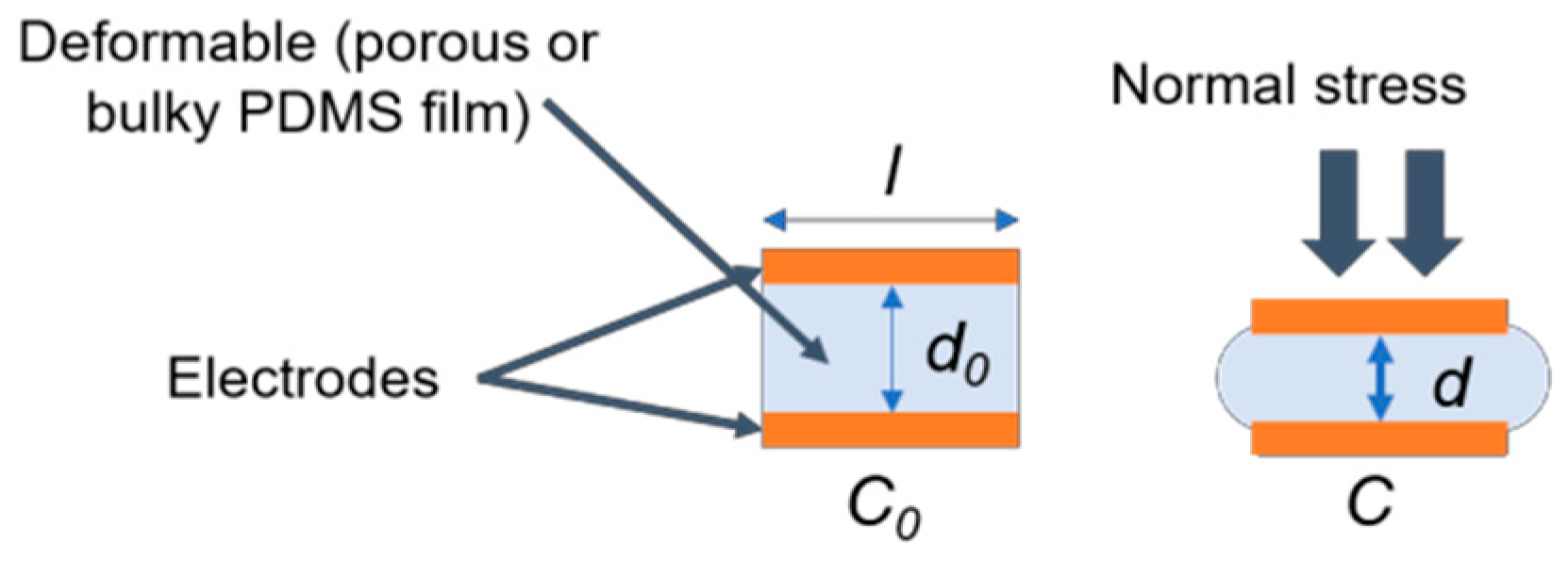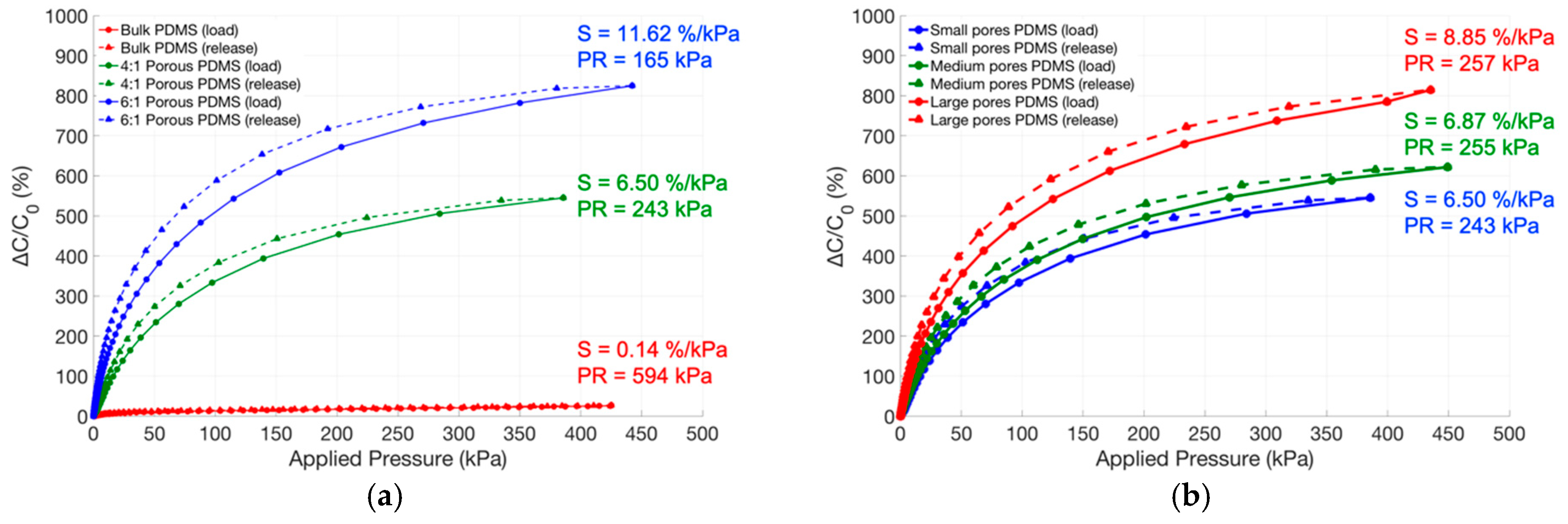Porous Polymer Based Flexible Pressure Sensors for Medical Applications †
Abstract
:1. Introduction
2. Sensor Principle
3. PDMS Foam
4. Sensor Electromechanical Characterization
5. Conclusions
Author Contributions
Conflicts of Interest
Acknowledgments
References
- Trung, T.Q.; Lee, N.E. Flexible and Stretchable Physical Sensor Integrated Platforms for Wearable Human-Activity Monitoringand Personal Healthcare. Adv. Mater. 2016, 28, 4338–4372. [Google Scholar] [CrossRef]
- Motha, L.; Kim, J.; Kim, W.S. Instrumented rubber insole for plantar pressure sensing. Org. Electron. Phys.Mater. Appl. 2015, 23, 82–86. [Google Scholar] [CrossRef]
- al Khaburi, J.; Dehghani-Sanij, A.A.; Nelson, E.A.; Hutchinson, J. Effect of bandage thickness on interface pressure applied by compression bandages. Med. Eng. Phys. 2012, 34, 378–385. [Google Scholar] [CrossRef]
- Huang, Y.; Yuan, H.; Kan, W.; Guo, X.; Liu, C.; Liu, P. A flexible three-axial capacitive tactile sensor with multilayered dielectric for artificial skin applications. Microsyst. Technol. 2017, 23, 1847–1852. [Google Scholar] [CrossRef]
- Dinh, T.-H.-N.; Martincic, E.; Dufour-Gergam, E.; Joubert, P.-Y. Mechanical characterization of PDMS films for the optimization of polymer based flexible capacitive pressure microsensors. J. Sens. 2017, 2017. [Google Scholar] [CrossRef]
- Chhetry, A.; Yoon, H.; Park, J.Y. A flexible and highly sensitive capacitive pressure sensor based on conductive fibers with a microporous dielectric for wearable electronics. J. Mater. Chem. C 2017, 5, 10068–10076. [Google Scholar] [CrossRef]




| Sugar:PDMS Volume Ratio | Sugar Crystal Sizes (µm) | Φ (%) | PC (kPa) | PR (kPa) | S (%/kPa) | Hysteresis (%) |
|---|---|---|---|---|---|---|
| 0:1 (bulk) | no crystal | 0 | 198 | 594 | 0.14 | 8.85 |
| 470 ± 100 | 78.58 ± 3.11 | 81 | 243 | 6.50 | 5.60 | |
| 4:1 (foam) | 700 ± 230 | 79.76 ± 1.42 | 85 | 255 | 6.87 | 5.43 |
| 1100 ± 330 | 81.22 ± 0.97 | 86 | 257 | 8.85 | 5.32 | |
| 6:1 (foam) | 470 ± 100 | 82.84 ± 1.28 | 55 | 165 | 11.62 | 6.43 |
| 700 ± 230 | 85.18 ± 0.85 | 61 | 183 | 13.07 | 4.58 |
Publisher’s Note: MDPI stays neutral with regard to jurisdictional claims in published maps and institutional affiliations. |
© 2018 by the authors. Licensee MDPI, Basel, Switzerland. This article is an open access article distributed under the terms and conditions of the Creative Commons Attribution (CC BY) license (https://creativecommons.org/licenses/by/4.0/).
Share and Cite
Bilent, S.; Dinh, T.H.N.; Martincic, E.; Joubert, P.-Y. Porous Polymer Based Flexible Pressure Sensors for Medical Applications. Proceedings 2018, 2, 849. https://doi.org/10.3390/proceedings2130849
Bilent S, Dinh THN, Martincic E, Joubert P-Y. Porous Polymer Based Flexible Pressure Sensors for Medical Applications. Proceedings. 2018; 2(13):849. https://doi.org/10.3390/proceedings2130849
Chicago/Turabian StyleBilent, Sylvie, Thi Hong Nhung Dinh, Emile Martincic, and Pierre-Yves Joubert. 2018. "Porous Polymer Based Flexible Pressure Sensors for Medical Applications" Proceedings 2, no. 13: 849. https://doi.org/10.3390/proceedings2130849
APA StyleBilent, S., Dinh, T. H. N., Martincic, E., & Joubert, P.-Y. (2018). Porous Polymer Based Flexible Pressure Sensors for Medical Applications. Proceedings, 2(13), 849. https://doi.org/10.3390/proceedings2130849




